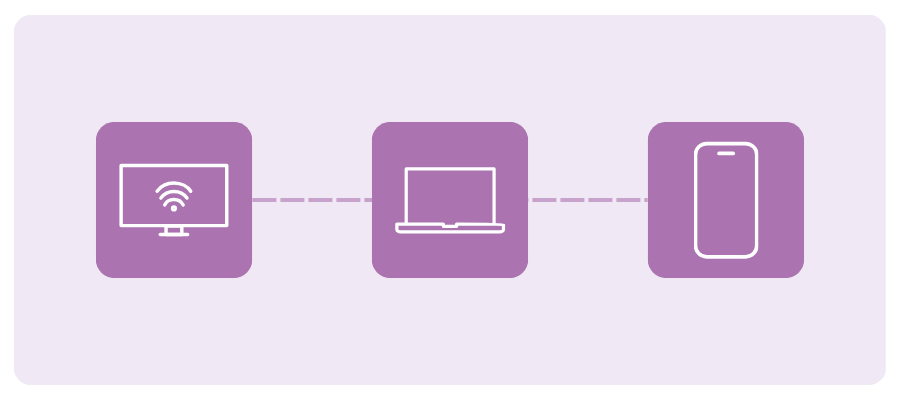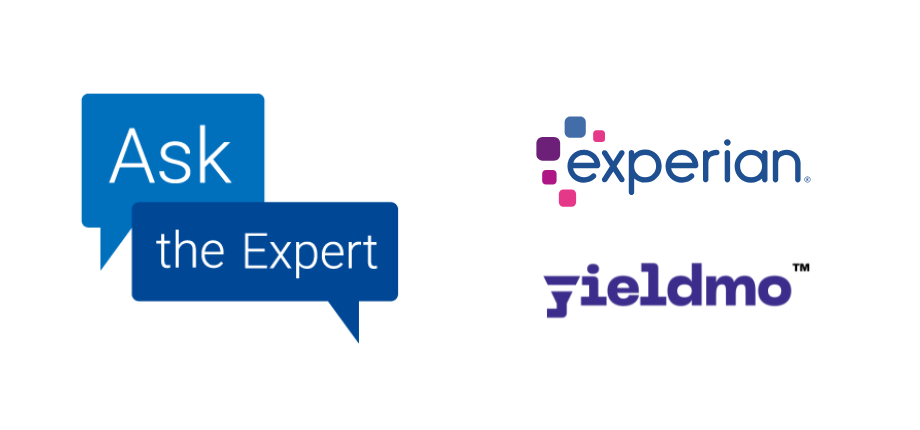At A Glance
Infillion and Experian collaborate to help advertisers connect with audiences across devices and channels, as cookies and mobile identifiers disappear. By integrating Experian's Digital Graph and Offline Identity Resolution, Infillion strengthens identity connections, improves campaign reach, and enhances audience engagement across CTV, mobile, and web.In our Ask the Expert Series, we interview leaders from our partner organizations who are helping lead their brands to new heights in AdTech. Today’s interview is with Ben Smith, VP of Product, Data Products at Infillion.
Adapting to signal loss
What does the Experian–Infillion integration mean for advertisers looking to reach audiences as signals fade?

As cookies and mobile identifiers disappear, brands need a new way to find and reach their audiences. The Experian integration strengthens Infillion’s XGraph, a cookieless, interoperable identity graph that supports all major ID frameworks, unifying people and households across devices with privacy compliance, by providing a stronger identity foundation with household- and person-level data. This allows us to connect the dots deterministically and compliantly across devices and channels, including connected TV (CTV). The result is better match rates on your first-party data, more scalable reach in cookieless environments, and more effective frequency management across every screen.
Connecting audiences across channels
How does Experian’s Digital Graph strengthen Infillion’s ability to deliver addressable media across channels like CTV and mobile?

Experian strengthens the household spine of XGraph, which means we can accurately connect CTV impressions to the people and devices in that home – then extend those connections to mobile and web. This lets us plan, activate, and measure campaigns at the right level: household for CTV, and person or device for mobile and web. The outcome is smarter reach, less waste from over-frequency, and campaigns that truly work together across channels.
The value of earned attention
Infillion has long championed “guaranteed attention” in advertising. How does that philosophy translate into measurable outcomes for brands?

Our engagement formats, such as TrueX, are based on a simple principle: attention should be earned, not forced. Viewers choose to engage with the ad and complete an action, which means every impression represents real, voluntary attention rather than passive exposure. Because of that, we consistently see stronger completion rates, deeper engagement, and clearer downstream results – like lower acquisition costs, improved on-site behavior, and measurable brand lift.
To take that a step further, we measure attention through UpLift, our real-time brand lift tool. UpLift helps quantify how exposure to a campaign influences awareness, consideration, or purchase intent, providing a more complete picture of how earned attention translates into business impact.
Creative innovation and location insights
Beyond identity resolution, what are some of Infillion’s capabilities, like advanced creative formats or location-based insights, that set you apart in the market?

One key area is location intelligence, which combines privacy-safe geospatial insights with location-based targeting through our proprietary geofencing technology. This allows us to build custom, data-driven campaigns that connect media exposure to real-world outcomes – like store visits and dwell time – measured through Arrival, our in-house footfall attribution product.
We also build custom audiences using a mix of zero-party survey data, first-party location-based segments, and bespoke audience builds aligned to each advertiser’s specific strategy.
Then there’s creative innovation, which is a major differentiator for us. Our high-impact formats go beyond static display, such as interactive video units that let viewers explore products through hotspots or carousels, rich-media ads that feature polls, quizzes, dynamic distance, or gamified elements, and immersive experiences that encourage active participation rather than passive viewing. These creative formats not only capture attention but also generate deeper engagement and stronger performance for a variety of KPIs.
Future ready media strategies
How does Infillion’s ID-agnostic approach help brands future-proof their media strategies amid ongoing privacy and tech changes?

We don’t put all our eggs in one basket. XGraph securely unifies multiple durable identifiers alongside our proprietary TrueX supply to strengthen CTV household reach. This agnostic design allows us to adapt as platforms, regulations, and browsers evolve – so you can preserve reach and measurement capabilities without getting locked into a single ID or losing coverage when the next signal deprecates.
Raising the bar for media accountability
Looking ahead, how is Infillion evolving its platform to meet the next wave of challenges in audience engagement and media accountability?
From an engagement standpoint, we’re expanding our ability to support the full customer journey, offering ad experiences that move seamlessly from awareness to consideration to conversion. That includes smarter creative that adapts to context, intelligent targeting and retargeting informed by real data, and formats designed to drive measurable outcomes rather than just impressions.
When it comes to accountability, we’re ensuring that measurement is both flexible and credible. In addition to our proprietary tools, we partner with leading third-party measurement providers to validate results and give advertisers confidence that their investment is truly performing. Within our DSP, we emphasize full transparency and log-level data access, ensuring advertisers can see exactly what’s happening on every impression.
All of this builds toward the next era of agentic media buying – one enabled by our MCP suite and modular, component-based tools. This evolution brings greater accountability and next-generation audience engagement to an increasingly automated, intelligent media landscape. Our goal is to help brands connect more meaningfully with audiences while holding every impression – and every outcome – to a higher standard of transparency and effectiveness.
Driving impact across the funnel
What is a success story or use cases that demonstrate the impact of the Experian–Infillion integration?
We recently partnered with a national veterans’ organization to raise awareness of its programs for injured or ill veterans and their families. Using the Experian integration, we combined persistent household- and person-level identifiers with cross-device activation to reach veteran and donor audiences more precisely across CTV, display, and rich media. The campaign achieved standout results – industry-leading engagement rates, a 99% video completion rate, and measurable lifts in both brand awareness (3.6 % increase) and donation consideration (13.7% lift). It’s a clear example of how stronger identity and smarter activation can drive meaningful outcomes across the full funnel.

Contact us
FAQs
Identity resolution ensures accurate connections between devices, households, and individuals. Experian’s Offline Identity Resolution and Digital Graph strengthen these connections for improved targeting and consistent measurement across CTV, mobile, and web.
Solutions like Experian’s Digital Graph enable brands to connect first-party data to household and person-level identifiers, ensuring scalable reach and compliant audience targeting legacy signals fade.
Focusing on earned attention (where audiences actively choose to engage) leads to stronger completion rates, improves on-site behavior, and drives measurable increases in brand awareness and consideration.
By linking CTV impressions to households and extending those connections to mobile and web, Experian’s identity solutions ensure campaigns work together seamlessly, reducing over-frequency and improving overall reach.
About our expert

Ben Smith, VP Product, Data Products
Ben Smith leads Infillion’s Data Products organization, delivering identity, audience, and measurement solutions across the platform. Previously, he was CEO and co-founder of Fysical, a location intelligence startup acquired by Infillion in 2019.
About Infillion

Infillion is the first fully composable advertising platform, built to solve the challenges of complexity, fragmentation, and opacity in the digital media ecosystem. With MediaMath at its core, Infillion’s modular approach enables advertisers to seamlessly integrate or independently deploy key components—including demand, data, creative, and supply. This flexibility allows brands, agencies, commerce and retail media networks, and resellers to create tailored, high-performance solutions without the constraints of traditional, all-or-nothing legacy systems.
Latest posts

Setting sail For hospitality and travel marketers, understanding which marketing efforts lead to actual bookings can be a tidal shift. Windstar Cruises—renowned for its intimate yachts and off-the-beaten-path itineraries—wanted data-driven visibility into how digital media placements translated into confirmed reservations. Windstar turned to the strategic media expertise of MMGY, a leading integrated marketing company dedicated to the travel, tourism, and hospitality industries and Experian's marketing data and identity solutions to bridge this gap. Together, they developed a closed-loop attribution system that directly tied digital campaigns to offline passenger bookings. The challenge: Blind spots in the booking journey Windstar Cruises had plenty of top-of-funnel metrics—impressions, clicks, website sessions, cruise quote requests—but struggled to connect these indicators to confirmed reservations. Without that link, it wasn't easy to pinpoint which audience segments were most valuable in their marketing campaigns or accurately measure return on ad spend (ROAS). Traditional attribution methods and limited booking system data painted an incomplete picture, leaving Windstar to wonder which media channels and audience strategies were truly driving revenue. MMGY and Experian: Bridging data gaps to power attribution Comprehensive pixel tag MMGY designed an online-offline measurement strategy and coordinated with Experian to deploy pixels across Windstar's digital media placements. These pixels captured valuable event-level data—ad exposures, clicks, site visits, and more—so that every interaction could be matched back to a future booking if it occurred. Identity resolution and data enrichment Using the Experian identity graph, Experian matched Windstar’s reservation data with its extensive consumer database. This approach provided a precise, individual-level view of how digital interactions translated into real-world sales. By combining pixel data (which identifies who viewed specific ads) with reservation data (which shows who ultimately made a booking), the solution delivered a comprehensive, end-to-end, multi-touch perspective on the customer journey. Advanced audience segmentation Utilizing MMGY’s powerful Terminal audience modeling platform—which integrates MMGY Travel Intelligence performance and intent data, Experian’s consumer intent data, and the client’s first-party data— MMGY in conjunction with Experian’s marketing analytics team developed custom audiences designed to drive incremental traveler growth. These audience segments identified travelers most likely to engage in the unique travel experiences Windstar offers. The insights revealed not only who these travelers are, but also where they consume media, how they make travel decisions, and what influences their purchasing behavior. This data guided the development of hyper-targeted media buys, ensuring Windstar’s messaging reached the right people on the right platforms at the right time—maximizing engagement and driving qualified leads. The results: Mapping spend to bookings By utilizing data connectivity and measurement, Windstar gained the insights needed to optimize every aspect of its marketing—audiences, media placements, channels, and more. This data-driven approach revealed which tactics were most effective and enabled Windstar to refine campaigns in real-time for maximum impact. 6,500+ bookings attributed to digital efforts: Over 6,500 bookings—valued at over $20 million—were tied to specific MMGY-managed placements, demonstrating which data-driven tactics led passengers to book. This level of attribution was only possible because we helped Windstar measure and connect the right data points. 13:1 ROAS: By investing $1.48 million in highly trackable, data-informed media, Windstar achieved an impressive 13:1 return on ad spend. Data connectivity gave Windstar the clarity needed to target the right audiences and channels—turning every $1 of spend into $13 of bookings. Actionable cost per booking benchmark: Armed with the ability to map ad spend to individual bookings, Windstar’s average cost per booking settled at $236. With insight into which audiences and placements performed best, Windstar adjusted its strategy in real-time, lowering acquisition costs across the board. High-value reservations: Attributed bookings were, on average, $500 higher in value than non-attributed bookings. By focusing on the right customer segments and messages—determined through precise measurement and segmentation—Windstar secured more bookings and maximized revenue per guest. Terminal Audiences outperformed: For Terminal-targeted segments, the ROAS soared to 28:1 with nearly half the cost per booking compared to non-Terminal audiences. This outcome illustrates how advanced data segmentation and connectivity deliver more profitable guests at lower acquisition costs—further proof that continuous optimization grounded in real data pays off. What this means for travel and hospitality Windstar's success story illuminates a bigger truth for the travel and hospitality industry: closing the attribution loop is no longer optional. In a fiercely competitive marketplace, brands need concrete proof that their marketing investments drive awareness and translates into real revenue. By marrying MMGY's travel-specific marketing acumen with Experian's marketing data and identity solutions, travel brands can: Invest with confidence: Marketing investment flows to the most effective channels and placements based on actual bookings, not superficial metrics. Refine strategies: Real-time attribution data creates a feedback loop marketers can use to iterate on messaging, creativity, and targeting for even stronger results. Capture higher-value guests: Pinpointing and appealing to likely travelers allows marketers to increase booking volume and total revenue per booking. Charting a course for data-driven success By seamlessly linking digital exposure to confirmed reservations, Experian and MMGY gave Windstar Cruises the compass they needed to navigate the complexities of digital marketing confidently. This new level of insight is empowering Windstar to double down on the campaigns, creatives, and segments that move the needle the most. For travel and hospitality brands worldwide, data-driven attribution goes beyond simply understanding what happened—it’s about shaping what comes next. When marketing decisions are guided by real customer journeys and precise ROI metrics, brands can make more innovative investments, foster stronger guest relationships, and chart a course toward sustainable growth. Ready to embark on your own data-driven journey? Contact us to learn how Experian and MMGY can help you create impactful, measurable marketing strategies. Contact us About MMGY MMGY is a leading integrated marketing company dedicated to the travel, tourism, and hospitality industries. With deep expertise spanning research, brand strategy, media planning, and creative execution, MMGY helps global travel brands forge meaningful connections with consumers. By utilizing data-driven insights, cutting-edge technology, and decades of experience, MMGY delivers strategic programs that capture attention and drive measurable results for its clients—ensuring that every marketing investment is tied to clear business outcomes. Latest posts

Linear TV advertising — also known as traditional or broadcast TV advertising — refers to scheduled ad programming broadcasted over traditional channels. While it doesn’t dominate the spotlight as it used to, it’s still a significant force in advertising today because of its vast potential to reach broad audiences and create memorable moments through high-profile events. Broadcast and cable TV, both forms of linear TV, still account for around 24% and 26% of U.S. TV viewership, respectively. As marketers look for ways to combine traditional and digital strategies, knowing how linear TV still fits into the mix can create value for brands and provide new opportunities for broader reach and engagement. This article explores the relevance and benefits of linear TV and how traditional broadcast television can complement digital platforms alongside changing viewing preferences. Linear TV vs. digital channels Even though linear TV has maintained impressive viewership, it’s impossible to ignore the growing influence of advanced TV platforms like OTT (over-the-top) streaming services and connected TV (CTV). These digital channels have changed how audiences consume content, complemented traditional linear TV, and created new marketing opportunities. Each offers unique advertising value, and knowing how linear and certain forms of advanced TV stack up can help advertisers make informed choices about where to focus their efforts. Linear TV Linear TV is regularly scheduled programming on networks like ABC or NBC. The name refers to its linear delivery of content on a set schedule, with all viewers tuning in at the same time. It's great for reaching large audiences during live events or prime-time shows but lacks the precise targeting options available on digital platforms. Targeting: Advertisers can only target broad demographics (age, gender, location) but not specific interests or behaviors. Ad format: Ad formats typically take the form of non-interactive ads, usually 15-, 30-, or 60-second spots shown during commercial breaks. Viewer engagement: Viewing is passive, as ads are shown at fixed times and cannot be skipped. OTT OTT refers to streaming services that bypass traditional cable or satellite to deliver content through the internet on platforms like Netflix, Hulu, and Peacock. Content is available on-demand and accessible on devices like laptops, tablets, smart TVs, and smartphones. OTT is flexible, so viewers can watch what they want when they want. Targeting: OTT offers precise targeting using interest, viewing behavior, and location data to personalize ads. Ad formats: Formats can include pre-roll, mid-roll, sponsored content, and sometimes interactive ads to drive engagement. Viewer engagement: Viewers can control their experience with the ability to pause, skip, or replay content depending on the platform’s features. CTV CTV refers specifically to televisions connected to the internet through built-in smart features or external devices like Apple TV, Amazon Fire TV, or Roku. CTV is a delivery mechanism for streaming OTT content to the TV screen, making it like an intersection between traditional TV and digital streaming. Targeting: Similar to OTT, CTV allows precise targeting based on viewer data such as preferences, behaviors, and geographic location. Ad formats: Includes pre-roll, mid-roll, post-roll, and, in some cases, interactive ad features like clickable banners or in-ad actions. Viewer engagement: Engagement levels are higher than linear TV, as viewers are often more active participants who can pause or interact with ads. A brief comparison: Linear TV, OTT, and CTV The main differences between OTT and CTV are in their delivery and access. OTT refers to the streaming services providing content, regardless of the device, while CTV refers to the internet-enabled TV screens through which OTT content is consumed. They’re complementary, with OTT defining the content and CTV shaping the viewing experience on the largest screen in the house. Each TV platform has its own strengths. Linear TV is great for reaching a broad audience with memorable ads, while OTT and CTV offer more precise targeting and greater viewer engagement. Advertisers should consider using a mix of these platforms, taking advantage of each one’s benefits to create a well-rounded advertising strategy. Benefits of linear TV in the modern advertising landscape While consumer behavior has shifted toward digital content consumption, the sheer scale and influence of pre-scheduled, real-time broadcast TV advertising makes it a powerful tool for brand advertising within a broad media strategy. When integrated with digital strategies, linear TV can widen your reach, foster brand safety, and boost viewer engagement, to name a few benefits. Mass reach and brand visibility Broadcast TV advertising has a massive reach, especially during live events and news broadcasts. It delivers content to large, diverse audiences at once — something digital platforms, with often fragmented and niche targeting, cannot achieve on the same scale. To put things in perspective, there are nearly as many linear TV viewers today (228 million) as social media users (236 million), according to eMarketer. This helps marketers earn brand visibility and recognition across broad demographics and make an impact on their target audience. Advertisers can also use linear TV to reach multiple individuals in a single household, making it an efficient way to run household-focused marketing campaigns. Linear TV advertising increases the likelihood that a diverse audience residing in one household will see your content. Brand safety and controlled environment One of linear TV's most important advantages is its controlled, brand-safe environment. Unlike digital platforms, where ads can appear alongside user-generated content or in unpredictable and sometimes risky settings, linear TV offers a more curated environment. Advertisers can be confident their message will be delivered in a professionally regulated context so viewers develop a positive, reliable brand association. Diversify your marketing mix Some demographics are underserved by digital channels and are more likely to see ads on linear TV than on an internet-connected device. Top U.S. advertisers obtain more impressions among adults over 55 using linear TV ads, with Baby Boomers spending an average of 5 hours and 46 minutes daily on linear TV. This highlights why it’s so critical to diversify your marketing mix with various channels that help you tap into audiences your competitors may not be. Preferred hosting for major events Digital platforms are hosting more live events every year, but linear TV is still the most successful and reliable medium for major events like elections, breaking news, award shows, primetime TV, and the Super Bowl. In fact, linear TV dominated the 2024 U.S. Presidential election, with major networks achieving off-the-chart ratings and more than 42 million cable viewers nationwide. Guaranteed ad exposure While many digital platforms allow viewers to skip ads, linear TV ads have stayed unskippable and ensured viewers receive full exposure to marketing content. With traditional TV ads reaching as long as 60 seconds, this guaranteed viewership is a chance you can’t miss to capture your audience's attention. Viewer engagement and ad recall Paired with CTV, linear TV is exceptionally good at engaging viewers and facilitating strong recall with high-quality content. A recent study by Brightline found that, even in 2024, linear TV maintains the highest ad attention with an attention rate of 54.5%, surpassed only by premium CTV with a 56.1% attention rate. When viewers are highly engaged with TV programming, they’re also more likely to remember the aired ads, which boosts ad effectiveness and sales potential. According to a Comcast Advertising study, long-form TV and streaming ads are also twice as memorable as short-form mobile digital ads. This study revealed that TV ads garnered more visual attention than digital mobile ads, as participants watched 71% of the TV ads compared to the 30% they watched on mobile. Ads viewed in the TV environment even resulted in 2.2x higher unaided recall and 1.3x greater purchase intent than mobile digital ads. Traditional TV advertising, combined with digital, creates a full-screen, lean-back viewing experience that makes lasting impressions and elevates consumer memory. Current trends in TV advertising While it's true that linear TV is facing a viewership decline as audiences shift to digital platforms, it’s not disappearing entirely. Advertisers are finding new ways to innovate within the confines of linear TV and using advancements in targeting, content delivery, and OTT platform integrations. Free ad-supported television services (FAST) For one, linear TV is finding a new lease on life through FAST services; FAST channels bridge the gap between traditional linear TV and contemporary streaming preferences to reshape how audiences engage with ad-supported content. The main appeal of FAST is its ability to deliver curated, genre-specific programming combined with on-demand options. Roughly 70% of streaming users know about FAST and have used it within the last three months. Unlike traditional video-on-demand (VOD) platforms focused on high-profile originals and on-demand access, FAST channels bring back the structured, live grid format that mimics classic TV viewing experiences. Services like Pluto TV, Tubi, and the Roku Channel have captured significant audience share by blending nostalgia with modern accessibility. These agile, scalable platforms help media companies quickly launch new channels, as they did with NBCUniversal’s recent addition of 48 channels on Freevee and Xumo Play. High-impact events Certain genres, like live sports and award shows, continue to dominate on linear TV, including: The Super Bowl Other major NFL games The NBA Finals The Olympics The Oscars The Grammy Awards The Emmy Awards These events attract massive audiences and are a prime spot for advertisers. However, even live sports are transitioning to OTT platforms like Netflix, Amazon, and Peacock. Platforms like Amazon Prime Video, Apple TV, and ESPN+ are starting to secure exclusive streaming rights for major sports events and changing viewership patterns, which creates fiercer competition for linear TV. On the flip side, marketers have new opportunities in OTT environments to enjoy the reach of traditional TV advertising with more precise targeting. Linear programmatic TV While linear TV faces growing competition from digital channels, it’s adapting to meet marketers’ needs through innovations like linear programmatic TV. This approach automates the buying and placement of ads on traditional TV so advertisers can apply data-driven insights for more precise targeting. Unlike traditional linear ad buys, which rely on fixed schedules and broad audience demographics, programmatic technology allows for greater efficiency, flexibility, and strategic alignment. Recent forecasts show linear programmatic TV growing steadily throughout 2025 and being a valuable transitional tool that combines linear TV’s reach with digital platforms’ personalization and measurability. Cloud TV Cloud TV modernizes the traditional TV advertising experience by combining its established infrastructure with the best features of digital streaming and OTT. Companies like Vodafone and Viacom18 are transforming linear TV into a more flexible and scalable cloud-based service that delivers linear content alongside streaming options. Users can now conveniently access live TV and on-demand content from one interface. Currently, platforms like YouTube TV and Hulu + Live TV blend linear broadcasts with OTT streaming in the cloud so that viewers can watch traditional TV channels and access on-demand shows all in one place. This means advertisers can deliver targeted, personalized messages to the right audiences without losing the large-scale reach of linear TV and engage people across live TV and digital content. Addressable TV and advanced targeting Linear TV has always been limited by broad targeting, showing the same ad to everyone, no matter who’s watching. Addressable TV changes the game, letting advertisers deliver different ads to specific households during the same program so brands can reach the right people with messages that matter to them. The key to making this work is authenticated audiences. These are viewers who log in to platforms with verified information, giving advertisers better insights into their interests, behaviors, and demographics. This level of audience data allows for smarter audience segmentation and more effective ads based on interests, demographics, and behaviors. With Experian’s addressable TV audiences and strategic partnerships, you can execute highly targeted and measurable TV campaigns. Using reliable first-party data and universal identifiers (like Unified I.D. 2.0), which link consumer profiles across devices and channels, we help brands reach the right viewers on traditional TV and CTV platforms and ensure the right person sees the right ad at the best time without overexposure. How to integrate linear TV with digital marketing strategies Integrating linear TV with digital marketing strategies starts with aligning campaigns with audience behaviors and preferences. Using data-driven insights, brands can ensure their TV efforts complement digital channels to create a unified, impactful experience. Experian simplifies this process with advanced identity resolution and audience insights. Our identity graph and syndicated audiences can help your brand: Link TV ad exposures to online engagement and create a seamless experience across platforms. Measure cross-channel performance and understand how linear TV contributes to digital outcomes. Use enriched audience data to tailor ads that resonate for relevance and consistency across TV and digital. We’re ready to help you maximize the effectiveness of your TV advertising campaigns. Ready to connect with Experian’s TV experts? Partner with a leader in data and identity to achieve the full potential of your television marketing. Our innovative tools and collaborations with top industry platforms provide exciting opportunities for you to reach and engage your ideal audience. Let us help you transform your strategies and maximize your marketing ROI with our advanced TV solutions. Talk to our TV experts Contact us Latest posts

In our Ask the Expert Series, we interview leaders from our partner organizations who are helping lead their brands to new heights in AdTech. Today’s interview is with Eric Shiffman, VP of Product Marketing at Yieldmo. Here are five key takeaways from Eric’s insights: Tailored campaigns with Experian data: Yieldmo integrates Experian’s trusted identity and audience data to deliver creative campaigns tailored to specific audiences, ensuring more meaningful engagement. Omnichannel activation made easy: Experian’s data marketplace helps Yieldmo expand its reach across display, mobile, and CTV, creating seamless cross-channel advertising strategies. Advanced targeting and insights: The combination of Yieldmo’s attention signals and Experian’s identity solutions allows advertisers to pinpoint audiences with precision and confidence. Driving results in key verticals: Retail, CPG, and automotive campaigns use Experian data on Yieldmo’s platform to achieve improved personalization, targeting accuracy, and measurable outcomes. Scalable and privacy-conscious advertising: Yieldmo’s partnership with Experian ensures scalable solutions that balance advanced targeting with privacy-focused practices, benefiting advertisers across all industries. About Yieldmo Yieldmo often describes itself as ‘the creative and media results company,’ using a predictive, provocative, and proven approach. Could you give us a brief overview of how this vision shaped the company and how you differentiate yourselves in ad tech? Yieldmo was built on the belief that every ad experience should be as engaging and human centered as the content around it. By merging creative excellence with advanced technology and AI, we enable advertisers to deliver custom ad formats that spark emotion and inspire action. Our proprietary attention signals and predictive format selection allow brands to optimize for outcomes before impressions are served. This approach, combined with privacy-safe inventory curation, ensures that our solutions stand out in their ability to deliver both creativity and results. Creative and inventory performance You’re known for delivering premium experiences across top-tier publishers. What strategies or innovations does Yieldmo employ to boost creative performance, increase engagement, and optimize inventory for your partners? At Yieldmo, we emphasize the fusion of creative and media. We utilize predictive AI and a vast dataset to generate, customize, and match creatives with the right audiences and page contexts, enabling proven performance and learnings. On the supply side, we elevate publisher inventory by aligning high-quality ads with relevant content in innovative, non-intrusive creative formats. This dual focus ensures that every impression is primed for engagement, delivering tangible value to advertisers and optimal monetization for publishers. Partnership with Experian As a partner of Experian, how do our identity and audience data complement Yieldmo’s platform, and why do you see this collaboration particularly beneficial for the broader advertising industry? Experian’s robust identity and audience data strengthen Yieldmo’s ability to serve precisely tailored creative experiences. By integrating Experian’s insights with our proprietary attention signals and AI-driven predictive systems, we can optimize audience targeting and engagement strategies. This partnership represents the advancement of outcome-driven advertising while giving brands the confidence of reaching the right consumers in meaningful ways. Interest in Experian's data marketplace Experian recently introduced a new data marketplace aimed at simplifying data partner audience activation across display, mobile, and CTV. Which elements of this offering are most exciting from your perspective, and how do you anticipate it shaping Yieldmo’s solutions? The unified approach of Experian’s data marketplace to streamline audience activation aligns seamlessly with Yieldmo’s vision of delivering data-driven creative optimization. The ability to activate comprehensive data sets across multiple channels expands our omnichannel solutions, bringing precision and scalability to advertisers. Lately, we have focused resources on delivering thoughtful, cross-channel creative experiences, so aligning audiences to those is a logical extension. Verticals using third-party data From your experience, which verticals or industries are most likely to activate third-party data campaigns on Yieldmo’s platform, and have you observed any emerging trends in how advertisers use data from Experian or other providers? The retail, CPG, and automotive industries have been leading adopters of third-party data, using it to fine-tune targeting and personalize their messaging. Recently, we’ve noticed a shift toward bringing more post campaign measurement insights to the supply side–brand lift, foot traffic, conversion–for better optimization, whereas historically this valuable dataset was trapped in buy-side platforms. Data utilization and success stories Could you share how Yieldmo’s data-driven approach has evolved and any standout success stories that highlight your platform’s impact and value to partners? Yieldmo has always prioritized data to inform creative decisioning, from predictive ad placements to real-time optimization. In this award-winning Humane Society case study, we utilized media curation and predictive creative to drive a >170% CTR increase, 5x the campaign benchmark, leading to more page visits and donations. Thanks for the interview. Any recommendations for our readers if they want to learn more? To learn more about our solutions and partnership opportunities, visit the Yieldmo website or contact your Experian account representative to schedule your free match test. Contact us About our expert Eric Shiffman, Vice President of Product Marketing, Yieldmo Eric Shiffman is a product marketing leader with extensive experience in advertising technology. At Yieldmo, he drives strategies that blend AI, creative optimization, and privacy-conscious solutions to deliver measurable creative and media results. Eric translates complex technologies into actionable messaging, positioning, and insights, and evangelizing products and solutions. His expertise spans creative optimization, data-driven advertising, CTV, and audience solutions. Latest posts